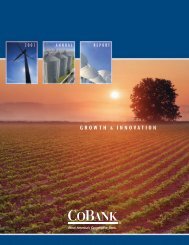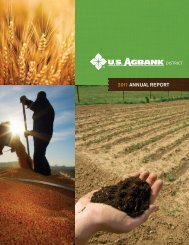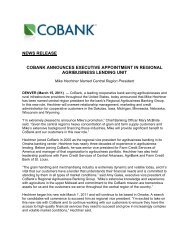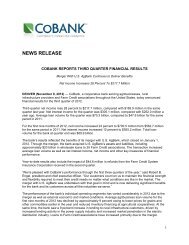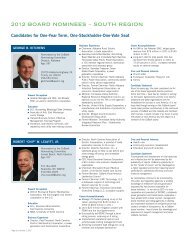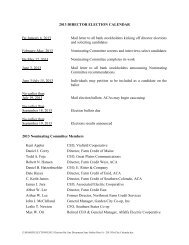In August 2011, Standard & Poor’s Ratings Services(S&P) downgraded the long-term sovereign credit rating ofthe United States from AAA to AA+ with a negative outlook.The credit ratings of GSEs, including the System, areinfluenced by the sovereign credit rating of the United States.As a result, S&P also lowered its long-term debt rating of theSystem from AAA to AA+. The ratings of individual Systembanks rated by S&P, including <strong>CoBank</strong>, were not affected.The other two major rating agencies, Moody’s InvestorsService (Moody’s) and Fitch Ratings (Fitch), have affirmedthe AAA sovereign credit rating of the United States and theAAA rating of the System. However, both Moody’s and Fitchhave assigned a negative outlook to the U.S. and Systemratings. Notwithstanding these actions, to date we havecontinued to access the funding necessary to support ourlending and business operations. However, such actions andany future downgrades could negatively impact funding costs,earnings and funding flexibility for <strong>CoBank</strong> and other Systeminstitutions.Our Funding Costs Would Increase if the Farm CreditSystem Lost its Status as a Government SponsoredEnterpriseThe System is a GSE and, as a member of the System,<strong>CoBank</strong> benefits from favorable debt-funding costs.Additionally, our individual credit ratings are positivelyimpacted by the GSE status of the System.The two largest housing GSEs, Fannie Mae and FreddieMac, have been under increased public and congressionalscrutiny as a result of their significant operating losses andU.S. government efforts to strengthen their capital and provideliquidity for securities they issue. Congressional deliberationsover structural reform related to these housing GSEs began in2011 and are likely to continue for a number of years. TheFarm Credit System has not been the subject of specificcongressional scrutiny, nor is it subject to the jurisdiction ofthe same congressional committees as the housing GSEs.However, we believe there is at least some risk that furtherefforts to regulate GSEs could impact the System’s status orerode some of the GSE-related benefits that it currentlyenjoys, including favorable funding costs and increasedfunding flexibility.We are Subject to Liquidity Risk with Respect to CertainInvestments and DerivativesWe are subject to liquidity risk in the course of ourinvesting activities, particularly with respect to ourinvestments in non-agency mortgage-backed securities (Non-Agency securities) and asset-backed securities (ABS), whichtogether represent approximately 2 percent of our investmentsecurities. As a result of volatile market conditions, it could bedifficult to sell such investments, if the need arises, and thediscounts from face value would likely be significant. Inaddition, because of the inherent uncertainty of determiningthe fair value of investments that do not have a readilyavailable market value, the fair value of our investments maydiffer significantly from the values that would have been usedhad a ready market existed for the investments.Our derivative contracts require the Bank or itscounterparties to post cash or securities as collateral when thefair values of the derivatives change based on changes ininterest rates. The collateral exchanged between parties occursdaily with zero posting thresholds for all dealer counterparties.As a result of these derivative contracts, we are exposed toliquidity risk when changes in interest rates require us to postcollateral to our counterparties. As of December 31, 2011, ourcounterparties had posted $792.3 million in cash and$58.9 million in securities as collateral with us. AtDecember 31, 2011, a parallel increase of 2.0 percentagepoints in the U.S. dollar LIBOR/swap curve would haverequired us to return substantially all of the collateral currentlyposted with us by our counterparties.Liquidity and Capital ResourcesFundingWe use our capital and both short-term and long-termborrowings to fund our assets. Our debt primarily representsSystemwide Debt Securities issued on <strong>CoBank</strong>’s behalf. Referto Notes 5 and 6 to the accompanying consolidated financialstatements for additional information regarding our debtobligations.As a member of the System, a GSE with continued strongearnings and capital levels, <strong>CoBank</strong> has traditionallymaintained ready access to debt-funding. As of December 31,2011, Systemwide Debt Securities were rated triple-A byMoody’s Investors Service and Fitch Ratings, and AA+ byStandard & Poor’s Ratings Services.Liquidity InvestmentsInvestment securities and cash are primarily held for thepurposes of maintaining a liquidity reserve and managingshort-term surplus funds. As detailed in Note 4 to theaccompanying consolidated financial statements, inaccordance with Board-approved policies, we purchase highcredit quality investments to ensure that the portfolio is readilymarketable and available to serve as a source of liquidity inthe event of disruption to our normal funding mechanisms.Investment securities totaled $13.0 billion atDecember 31, 2011, and $12.6 billion at December 31, 2010.Our cash balances were $2.8 billion and $1.9 billion atDecember 31, 2011 and 2010, respectively. The followingtable summarizes our investment securities and relatedunrealized gains/losses by asset class.<strong>CoBank</strong> 2011 <strong>Annual</strong> <strong>Report</strong>55
Investment Securities ($ in Millions)December 31, 2011AmortizedCostFairValueUnrealizedGains(Losses)U.S. Treasury and Agency Debt $ 3,549 $ 3,638 $ 89U.S. Agency Mortgage-Backed 8,899 9,061 162Non-Agency Mortgage-Backed 265 242 (23)Asset-Backed 78 54 (24)Total $ 12,791 $ 12,995 $ 204December 31, 2010U.S. Treasury and Agency Debt $ 3,311 $ 3,358 $ 47U.S. Agency Mortgage-Backed 8,673 8,739 66Non-Agency Mortgage-Backed 424 402 (22)Asset-Backed 143 118 (25)Total $ 12,551 $ 12,617 $ 66We regularly perform impairment assessments of ourinvestment securities based on evaluations of both current andfuture market and credit conditions and expected cash flows ofthese securities. Subsequent changes in market and creditconditions or expected cash flows could change theseevaluations.As all of our investment securities are classified as“available for sale”, we recognize changes in the fair value ofour investment securities in accumulated other comprehensiveincome (loss), a component of shareholders’ equity, unlesslosses are credit-related and considered other-than-temporary,in which case that portion of the loss is recorded in earnings.We recorded unrealized gains on our investment securities of$138.8 million and $69.6 million in 2011 and 2010,respectively. The unrealized gains in both years primarilyrelate to the impact of interest rate changes on the values ofcertain fixed-rate securities.Credit risk in our investment portfolio is primarily limitedto the 2 percent of investment securities that do not containeither an implicit or explicit guarantee of the U.S. government,consisting of Non-Agency securities and ABS. The unrealizedlosses on such securities primarily relate to decreased marketliquidity and widened credit spreads. We recorded impairmentlosses in earnings of $10.0 million in 2011 and $44.0 millionin 2010. The impairment losses in 2011 related to four Non-Agency securities and four ABS, and totaled $5.5 million and$4.5 million, respectively. Increasing levels of defaults andforeclosures on residential mortgages, continued highunemployment, and weak economic conditions may result infurther downward adjustments to the fair value of our Non-Agency securities and ABS and the need to record additionalimpairment losses in earnings.As of December 31, 2011, all of our ABS are composedof home equity securities. These securities are supported byfirst- or second-lien mortgages and the substantial majority ofthem are insured by two bond insurance companies that havecome under financial stress. During 2010 and 2009, wedetermined that we could no longer rely on these two bondinsurers to fulfill their obligations related to certain ABS theyinsure, which resulted in $23.0 million of the 2010 impairmentlosses and $11.0 million of the 2009 impairment losses.DerivativesAs noted previously, we use derivatives in part to manageour liquidity position. Derivatives are recorded at fair value asassets or liabilities in the accompanying consolidated balancesheets. Changes in the fair value of these derivatives areaccounted for as gains or losses through current periodearnings or as a component of accumulated othercomprehensive income (loss), depending on the use of thederivatives and whether they qualify for hedge accountingtreatment. Net changes in the fair value of derivatives andhedged items recorded in the accompanying consolidatedstatements of income totaled gains of $12.3 million and$2.7 million for 2011 and 2010, respectively. Changes in thefair value of derivatives recorded as other comprehensiveincome (loss) totaled losses of $0.5 million and $6.3 million in2011 and 2010, respectively.CapitalWe believe that a sound capital position is critical to ourlong-term financial success and future growth. We areprimarily capitalized by common and preferred stock and byunallocated retained earnings. Our shareholders’ equityincreased by $489.3 million during 2011. This increase wasprimarily due to $706.6 million of earnings and a$101.9 million increase in accumulated other comprehensiveincome, primarily resulting from unrealized gains in ourinvestment portfolio, net of tax. These factors were partiallyoffset by $230.8 million in cash patronage, $63.8 million inpreferred stock dividends and $24.6 million of common stockretirements, net of stock issuances.As of December 31, 2011, we had $700.0 million ofpreferred stock outstanding. In 2008, our shareholdersapproved a measure allowing <strong>CoBank</strong> to issue preferred stock,subject to FCA approval, up to the then bylaw limit of$1.0 billion outstanding, at any time through September 2018.This measure allows us to access outside capital more quicklyand efficiently in response to dynamic market conditions,without the necessity of obtaining shareholder approval foreach issuance. In September 2011, in connection with themerger with AgBank, shareholders approved an increase to thelimits of both the preferred stock authorization and the bylawsto $1.5 billion. In conjunction with the merger, on January 1,2012, AgBank’s $225.0 million (par value) of preferred stockwas converted into $225.0 million (par value) of a new seriesof <strong>CoBank</strong> preferred stock with substantially the same termsand conditions.<strong>CoBank</strong> 2011 <strong>Annual</strong> <strong>Report</strong>56
- Page 4 and 5:
Everett DobrinskiChairmanRobert B.
- Page 6 and 7:
“ We firmly believe the combined
- Page 8 and 9:
associations are partnering with Co
- Page 11 and 12: 2012 BOARD OF DIRECTORSOccupation:F
- Page 13 and 14: “WE ARE COMMITTEDTO GOOD GOVERNAN
- Page 15 and 16: U.S. AgBank CEO Darryl Rhodes (fron
- Page 17 and 18: KansasNew MexicoUtahFC of Ness City
- Page 19 and 20: CorporateCitizenshipAT COBANKSuppor
- Page 21 and 22: StrategicRelationshipsFarm Credit o
- Page 23 and 24: RegionalAgribusinessBANKING GROUPCe
- Page 25 and 26: CorporateAgribusinessBANKING GROUPK
- Page 27 and 28: ElectricDistributionBANKING DIVISIO
- Page 29 and 30: Power SupplyBANKING DIVISIONTri-Sta
- Page 31 and 32: IndustryPortfoliosCoBank ended 2011
- Page 33 and 34: CoBank is a financially strong,depe
- Page 35 and 36: 30COBANK 2011ANNUAL REPORTbuilding
- Page 37 and 38: The information and disclosures con
- Page 39 and 40: Financial Condition andResults of O
- Page 41 and 42: Provision for Loan Losses and Reser
- Page 43 and 44: Purchased services expense decrease
- Page 45 and 46: AgribusinessOverviewThe Agribusines
- Page 47 and 48: Rural InfrastructureOverviewThe Rur
- Page 49 and 50: Credit ApprovalThe most critical el
- Page 51 and 52: Total nonaccrual loans were $134.9
- Page 53 and 54: Basis RiskBasis risk arises due to
- Page 55 and 56: Our net interest income is lower in
- Page 57 and 58: The notional amount of our derivati
- Page 59: Reputation Risk ManagementReputatio
- Page 63 and 64: In accordance with the Farm Credit
- Page 65 and 66: Critical Accounting EstimatesManage
- Page 67 and 68: Business OutlookWe closed our merge
- Page 69 and 70: Consolidated Income StatementsCoBan
- Page 71 and 72: Consolidated Statements of Cash Flo
- Page 73 and 74: Consolidated Statements of Changes
- Page 75 and 76: LoansWe report loans, excluding lea
- Page 77 and 78: If we determine that a derivative n
- Page 79 and 80: Reserve for Credit ExposureThe foll
- Page 81 and 82: The information in the tables under
- Page 83 and 84: The following tables present inform
- Page 85 and 86: At December 31, 2011, gross minimum
- Page 87 and 88: For impaired investment securities,
- Page 89 and 90: At December 31, 2011, the assets of
- Page 91 and 92: Preferred StockThe following table
- Page 93 and 94: The following table provides a summ
- Page 95 and 96: AssumptionsWe measure plan obligati
- Page 97 and 98: Incentive Compensation PlansWe have
- Page 99 and 100: Note 11 - Derivative FinancialInstr
- Page 101 and 102: A summary of the impact of derivati
- Page 103 and 104: Due to the uncertainty of expected
- Page 105 and 106: Assets and Liabilities Measured atF
- Page 107 and 108: Note 14 - Segment Financial Informa
- Page 109 and 110: Note 15 - Commitments and Contingen
- Page 111 and 112:
Note 18 - Subsequent Events (Unaudi
- Page 113 and 114:
Supplemental District Financial Inf
- Page 115 and 116:
Supplemental District Financial Inf
- Page 117 and 118:
Report of Independent AuditorsCoBan
- Page 119 and 120:
Management’s Report on Internal C
- Page 121 and 122:
Annual Report to Shareholders Discl
- Page 123 and 124:
Board of Directors Disclosure as of
- Page 125 and 126:
Board of Directors Disclosure as of
- Page 127 and 128:
Board of Directors Disclosure as of
- Page 129 and 130:
Board of Directors Disclosure as of
- Page 131 and 132:
Senior OfficersCoBank, ACBRobert B.
- Page 133 and 134:
Senior Officers Compensation Discus
- Page 135 and 136:
Senior Officers Compensation Discus
- Page 137 and 138:
Senior Officers Compensation Discus
- Page 139 and 140:
Senior Officers Compensation Discus
- Page 141 and 142:
Senior Officers Compensation Discus
- Page 143 and 144:
Senior Officers Compensation Discus
- Page 145 and 146:
Code of EthicsCoBank, ACBCoBank set
- Page 147 and 148:
CERTIFICATIONI, Robert B. Engel, Pr
- Page 149 and 150:
LeadershipCoBank, ACBRobert B. Enge
- Page 151 and 152:
OfficeLocationsCoBank National Offi




